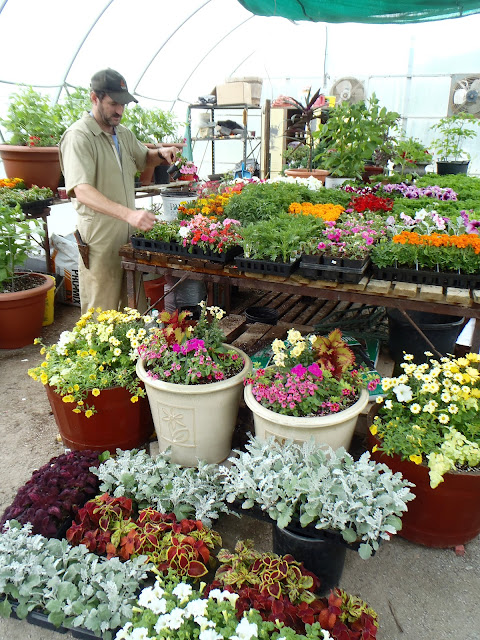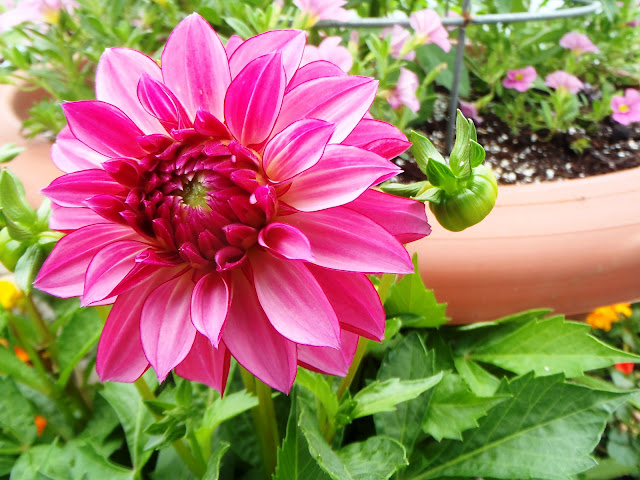 |
| Here's Stuart with some of the arrangements he has put together. |
 |
| On of the mini Dahlias up close. |
The storm that can through last weekend dumped close to 30mls of rain on the golf course and was a good test for our drainage on number eight. With in a couple of hours the area was draining well and the trap was dry by the next morning. We are happy to say the project was a success.
At the Gala event of Friday on of the members asked me about the "graveyard on number 12". They were jokingly referring to the rope and stakes in the middle of the fair way by the bunkers. This area is the point where the old pump house piping from Fish Lake joined the irrigation system. Last Year Kyle and I dug up the joint and capped off the feed lines from the Lake. We discovered that when the system was originally installed the contractor had bedded the pipe in sand. The bedding was quite large, almost ten feet by six feet. Because the native soil here is clay and drains poorly, and we had disturbed the surface, the sand in repair area acted like a giant pool.
 |
| Dean and Gavin started by removing the sod and then began digging a trench that would link the wet area to an existing drain farther down the fairway. |
 |
| The material was removed and a four inch big "O" drainage pipe installed. Then filter cloth to prevent the gravel from being contaminated and finally the sod was replaced. |
This week Kyle and I applied our "baseline" granular fertilizer application to the greens. The fertilizer has a very small grain or "prill" that is engineered to settle down into the canopy of the grass and not interfere with putting. Each prill has layers of coating that slowly break down over time, based on temperature and moisture. It is imperative that the fertilizer we use on the greens is designed this way or we would see bursts of growth that would be used up too quickly, create excessive growth, and then required re-application. The product is referred to as a "slow release fertilizer" which is designed to deliver 1/10th of a pound of nitrogen over 1000 square feet a week for the next fourteen weeks. While feeding constantly through out the summer, the amount of nitrogen is not enough to sustain the turf through the stress of play and summer weather. To combat this we spray a liquid fertilizer on the greens at very light rates bi weekly through out the season. The granular application provides a "baseline" and the liquid "spoon feeds" during times of need. This method allows us to control the growth rate and prevent bounces and low points, each of which have undesirable effects. Not enough growth, the greens falter from recovery of stress and with too much growth the green speed becomes uncontrollable. Because our baseline feed is so important to the health of the greens, we take extra care in the application. The rate is divided in half and then the greens are fertilized in two different directions, ensuring that the entire green surface is covered evenly. Our rate for this years baseline (it changes from the results of our soil tests) was 5 pound of product over 1000 square feet. After dividing that for two directions it becomes 2.5 lbs./1000 sqr. feet, which works out to 1 lb. of Nitrogen/1000sqr. feet for the full application. The total amount of product used was 825 lbs over all of our greens. Here's a video of the process.
We won't see any release from the granular application for a week or so. Tomorrow our application of the liquid fertilizer will be applied to the greens along with a product called Primo. Primo is a growth regulator that helps us to control the bounce even further. Primo reduces vertical growth and forces the plant to transfer it's energy to horizontal growth, thereby speeding up ball mark recovery and decreasing the friction of the vertical grass blades on the ball.
In keeping with some of the suggestions from the SPI, we have begun the trial of painting the upper lip of the hole white. If you were wondering how it accomplished have a look at this video of Nathan, our all star pin changer, applying the paint.
We are finding that at the end of the day the white paint is chipped and faded from use. We encourage your feedback as to the process. Would you like us to continue?
One of the great things about working at a golf course being around nature. This morning, Franklin (as named by Barb), our Snapping Turtle has returned to her lay eggs in the trap on beside 12 green (I don't think Barb thought the name through). She digs around in the edges of the sand trap looking for a suitable place to deliver her clutch and the eventually gives up and finds a less busy place. We have never seen the eggs hatch or any evidence of baby turtles in the area, but rest assured we avoid damaging the eggs when we see them.
All joking aside, Franklin is still a snapping turtle, and at this point very cranky. Do not attempt to pick her up (turtles can carry salmonella) and don't try to herd her out of the way. Snapping turtles can break fingers quite easily. Franklin is very aggressive and when she wants to be, very quick. I realize in the video I am provoking her with my boot, but it's to show exactly how fast she can be.




No comments:
Post a Comment